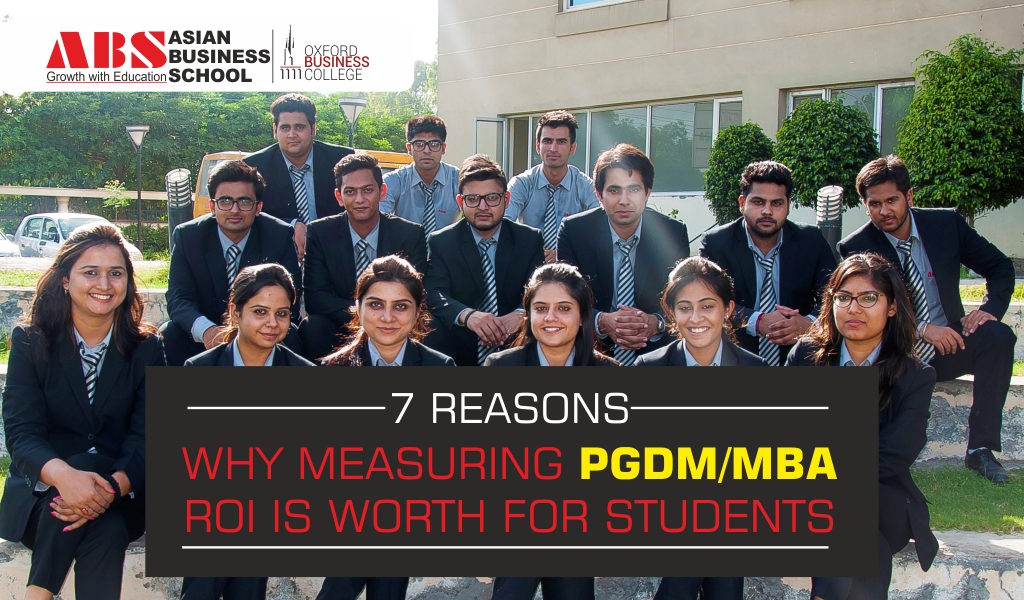In India, PGDM/MBA still remains one of the most lucrative post graduate qualification that gives phenomenal career growth and lucrative job opportunities. While seeking an admission into premier Indian B-School is extremely competitive, the amount of investment needed to pursue a PGDM/MBA programme from premier B-Schools like Indian Institute of Management-Ahmedabad or Xavier School of Management is in the range of Rs 20 to Rs 25 lakhs. Return on Investment (ROI) is generally used to measure the efficiency of an investment or compare the efficiency of a number of different investments when there are several options available. Basically, ROI tries to directly measure the amount of return on a particular investment, relative to the investment’s cost.
To calculate the ROI, the benefit (or return) of an investment is divided by the cost of the investment. The result is expressed as a percentage or a ratio which is ROI = (Current Value of Investment – Cost of Investment) / Cost of Investment. Discussed below are seven reasons stating the importance of how and why measuring ROI is worth for students
- The value of the network created
The conventional formulae of ROI might not give the exact ROI that a PGDM/MBA would give to an aspirant, as pursuing a PGDM/MBA programme also gives a lot of intangible value and benefit to an aspirant. An intangible value is the present value of excess earning power of an entity over the normal rate of return. The network that an aspirant creates while pursuing his/her PGDM/MBA qualification, the opportunities to interact with corporate stalwarts, the brand association that remains with the aspirant for their life time are some of the intangible benefits which are of immense value. Calculating ROI by considering all these aspects is important as it gives a student the ‘true value’ of his/her investment in a PGDM/MBA program.
- The intangibles – A Goldmine
One of the most important intelligible benefit that a B-School could provide to aspiring students is the alumni connect. There is an incredible advantage that an active network of alumni would give to those graduates who join Indian B-schools. The relative strength of the alumni network has the potential to affect the entire career of a student. If the alumni base is full of receptive, engaging and successful people, the aspirant has automatically acquired a priceless asset which is intangible. Hence, while aspirants calculate the ROI, they must also consider the opportunities that the B-School provides for adding intangible benefits — this is really important for a PGDM/MBA aspirant.
- Total Value Proposition
For example, let’s take B-School ‘ABC’ where the B-School doesn’t enjoy great brand equity and doesn’t provide impressive intangible benefit to its students, but charges Rs 5 lakh as the annual fee for the PGDM/MBA programme and offers its students job opportunities with an average pay package of Rs 6 lakh. Another B-School ‘DEF’, which enjoys great brand equity and provides impressive intangible benefit to its students, and charges Rs 6 lakh as the annual fee for the PGDM/MBA programme and offers its students job opportunities with an average pay package of Rs 6 lakh. Many students would rate the B-School ‘ABC’ to be having a better ROI but in reality B-school ‘DEF’ has a better ROI. Therefore, considering the total value proposition while computing ROI is important.
- The Opportunity Cost
Many aspirants opt to pursue a PGDM/MBA after acquiring some work experience. The salary that could be earned while pursuing a PGDM/MBA must also be considered by calculating ROI. This is called the opportunity cost associated with pursuing an PGDM/MBA programme and becomes an important aspect of ROI calculation. Hence, tuition fees plus salary foregone while studying, set against the salary premium achieved upon graduation, factoring in incremental increases in both pre and post-PGDM/MBA salaries have to be included in ROI computation.
- Salary-to-debt ratio
The cost of a PGDM/MBA qualification can be relatively high, but that cost coincides with higher starting salaries for PGDM/MBA graduates. Many predominantly calculate and compare a PGDM/MBA programme’s ROI to others using the average salary-to-debt ratio. The figure used for the salary component tends to be based on starting salaries, while the debt figure is the total debt one would assume to attain the degree. This is one of the most common methods you will see quoted by media houses while computing ROI. If the average starting salary at a B-School is around Rs 17,50,000 and the average debt (bank loan) taken by the aspirant is Rs 12,00,000, then the salary-to-debt ratio is 1.45-to-1.
- Long-term projection
Long-term salary projections account for raises and other income hikes a PGDM/MBA graduate might earn over time. One can then use this projection instead of a starting salary to calculate the salary-to-debt ratio. One thing to note here is that the time period may vary, but about 10 years is a typical length of time to calculate. One can then compare their projected 10-year salary with a 10-year salary without a PGDM/MBA for another ROI factor.
- The freedom and value of being an entrepreneur
The sense of independence that comes from owning a business cannot be understated, but it is also not easily financially quantified. A PGDM/MBA qualification can offer a lot when it comes to taking greater control over ones’ career direction and progression. Some prefer to have control over their own start-up, while others may prefer to take up jobs with the corporate instead of actual business ownership. This is a personal preference but the knowledge acquired, the eco-system provided for the support and the connection to angel and venture capital firms are all worth the cost of the degree and assigning them a value is most important while computing the ROI of a PGDM/MBA programme.


